Season's Eatings

Yes, once again 'tis the season to stuff your bird and stuff your face.
We like a traditional goose for the Christmas bird in our house; lovely succulent meat, never dry. Plus you get about a year's worth of beautiful fat for your roasties. Anyway, if it was good enough for the Cratchits it's good enough for us!
Following our traditions I picked the stuffing and the starter. I quite liked the sound of Nigella's gingerbread stuffing so we went with that. We were slightly worried that it might turn out too sweet, so we replaced some of the gingerbread with regular bread, but to be honest it was still a bit overwhelmingly sweet and sticky. I think I might go back to something a bit more traditional next year.
Unusually this year we also had a roast duck.
Since my brother decided to have himself a family we are now forced to get dressed (get dressed! On Christmas day! The horror!) and treck the mile upon mile (yes: two miles) to his place for Christmas Dinner. So fearing there wouldn't be enough leftover bird to feed two families for one entire day, Mum and I decided to have a second Christmas dinner at home on Boxing day with a duck. We were taking no chances.
For starters we made up some of Aidan's goats cheese parcels, which seemed to travel well when Aidan brought them around to my place, but unfortunately Mum ignored all my careful instructions on how to cut up the cheese and instead mashed it to paste before I got the chance to stop her. So they were a bit soggier than I had hoped.
main fowl
A couple of things I relearned this Christmas about making gravy:
- If you make sure to keep some water in the bottom of the bird's roasting tin you'll get a nice rich dark stock under the layer of fat to make your gravy with. Without the water you might just end up with a burnt crust and unusably bitter fat.
- Gravy thickens with between 1 and 3 tablespoons of flour fried in an equal volume of fat for each pint of liquid. So a litre of gravy needs 2 tablespoons flour for thin and up to 6 tablespoons for extra thick gravy. If you're using cornstarch then you'll only need about 2 teaspoons per pint.
- You can finish your gravy with a variety of flavours:
- orange juice ideally a mandarin such as satsuma, clementine, or tangerine, lemon juice, or zest from either
- port or red wine, Madeira, Marsala, white wine or even cider probably best used to deglaze the roasting tin
- any other liquor or brandy
- Worcestershire sauce or mushroom ketchup
- mustard
- spices, tomato purée or ketchup possibly best fried with the flour
- redcurrant jelly, jam, or other preserve
- garlic and anchovies apparently!
- marmite or bovril if you're a complete philistine
- a whisk of butter to add a little gloss
- Apparently bird roasting times can actually be dramatically less than the standard 20 minutes per pound recommended by cookery writers since the dawn of time. Felicity Cloake even claims to have cooked a 6kg turkey in just two hours - unlikely as that seems. I have to say though, that the low temperature roasting times for our goose were pretty much as advertised. And we used a meat thermometer and everything.
Ingredients:
It's a bitter-sweet meal - marking as it does the end of Christmas. The delicious end of Christmas.
Nothing left after that but to start working on those leftover mince pies.
Roast Duck
main fowl
Our 6lb duck was just perfect after 2½ hours cooking,
with the last half hour at a slightly higher temperature to crisp it up.
Serves 4
Ingredients
- 1 duck
- herbs, garlic or fruit for stuffing optional
Pre-heat the oven to 220°C/425°F/Gas Mark 7.
Untruss the duck and remove the wing tips (if present).
Prick (or slash) the duck skin all over, at about 1" spacing. Make sure to pierce through the skin into the fat layer, but don't penetrate the bird's flesh. This is to make sure that the fat runs out and leaves the bird with a nice crispy skin, without losing any of the meat juices.
Reduce the heat to 180°C/350°F/Gas Mark 4 after 15 minutes or so once the fat has started to crackle, and cook the bird for about 20 minutes plus 20 minutes per lb, basting every 20 minutes or so if you like, or the skin is looking a bit dark.
You can turn the temperature back up again for 20 minutes at the end to get the skin crispy and golden.
Untruss the duck and remove the wing tips (if present).
Prick (or slash) the duck skin all over, at about 1" spacing. Make sure to pierce through the skin into the fat layer, but don't penetrate the bird's flesh. This is to make sure that the fat runs out and leaves the bird with a nice crispy skin, without losing any of the meat juices.
Reduce the heat to 180°C/350°F/Gas Mark 4 after 15 minutes or so once the fat has started to crackle, and cook the bird for about 20 minutes plus 20 minutes per lb, basting every 20 minutes or so if you like, or the skin is looking a bit dark.
If you like you can turn the bird a couple of times too - we started the bird on it's breast then flipped it onto it's back about halfway
- but I'm not convinced it's necessary.
The bird is ready when the juices run clear when penetrated between thigh and breast
and the temperature of the thickest part of the bird reaches 75°C/165°F.You can turn the temperature back up again for 20 minutes at the end to get the skin crispy and golden.
You don't really want to stuff a duck as it will suck in too much fat, but feel free to throw a handful of herbs,
garlic, tart cherries, orange or lemon rind or pieces into the cavity to infuse a little flavour.
Gingerbread Stuffing
ingredient side
This makes an edible but very sweet, dense, heavy stuffing.
Very sweet.
A bit too sweet if you ask me.
It might be worth trying with regular bread replacing some of the gingerbread, but I think I'll be doing a different stuffing this time next year.
Very sweet.
A bit too sweet if you ask me.
It might be worth trying with regular bread replacing some of the gingerbread, but I think I'll be doing a different stuffing this time next year.
Fills 1 Goose
Ingredients
- 500g (3 medium-sized) onions
- 2 eating apples, peeled and cored
- 45g butter
- 1 x 15ml tablespoon vegetable oil
- 750g streaky bacon
- zest of 2 clementines/satsumas
- 2 x 400g gingerbread loaves (such as McVitie's Jamaica ginger cake), loosely crumbled
- 2 eggs, beaten approx.
- ½ teaspoon freshly ground pepper
Using a food processor or by hand, finely chop the onions and apples.
Put the butter and oil in a large, wide saucepan over a medium heat and fry the chopped onions and apples until soft, about 10-15 minutes.
Finely chop the bacon in the processor, or by hand, and add this to the softened onion and apple mixture. Cook everything, stirring frequently, for about 5 minutes more.
Add the zest of the clementines/satsumas.
Take the pan off the heat and let it cool a little before mixing in the gingerbreadcrumbs. You can let this get properly cold now if you want.
Just before you want to cook the stuffing, add the beaten eggs and pepper,and use it to stuff the cavity of your bird, or cook all of it (or what's left after stuffing your bird) in a buttered baking dish. I don't stuff the bird but put all of my stuffing in a very generously buttered old Le Creuset terrine, with internal dimensions of approx. 25cm x 9cm x 7cm deep.
Bake it in a hot oven (200°C/gas mark 6) with your turkey for about the last 45 minutes. If the stuffing's going into a full oven - which it no doubt is - there should be no need to cover the dish. If the oven is less full, and therefore hotter and less steamy, you could cover with foil for the first 30 minutes.
Let the cooked stuffing sit in its terrine for a good 10 minutes out of the oven before turning it out and slicing it. Or just spoon from the dish if that's less stressful. (I love a slice of this, cold, in a Christmas night or Boxing Day turkey sandwich.)
Put the butter and oil in a large, wide saucepan over a medium heat and fry the chopped onions and apples until soft, about 10-15 minutes.
Finely chop the bacon in the processor, or by hand, and add this to the softened onion and apple mixture. Cook everything, stirring frequently, for about 5 minutes more.
Add the zest of the clementines/satsumas.
Take the pan off the heat and let it cool a little before mixing in the gingerbreadcrumbs. You can let this get properly cold now if you want.
Just before you want to cook the stuffing, add the beaten eggs and pepper,and use it to stuff the cavity of your bird, or cook all of it (or what's left after stuffing your bird) in a buttered baking dish. I don't stuff the bird but put all of my stuffing in a very generously buttered old Le Creuset terrine, with internal dimensions of approx. 25cm x 9cm x 7cm deep.
Bake it in a hot oven (200°C/gas mark 6) with your turkey for about the last 45 minutes. If the stuffing's going into a full oven - which it no doubt is - there should be no need to cover the dish. If the oven is less full, and therefore hotter and less steamy, you could cover with foil for the first 30 minutes.
Let the cooked stuffing sit in its terrine for a good 10 minutes out of the oven before turning it out and slicing it. Or just spoon from the dish if that's less stressful. (I love a slice of this, cold, in a Christmas night or Boxing Day turkey sandwich.)
Sweet and sticky, just like Nigella.
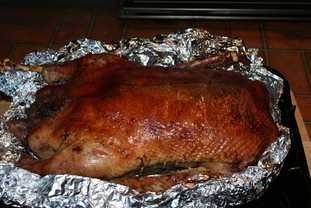
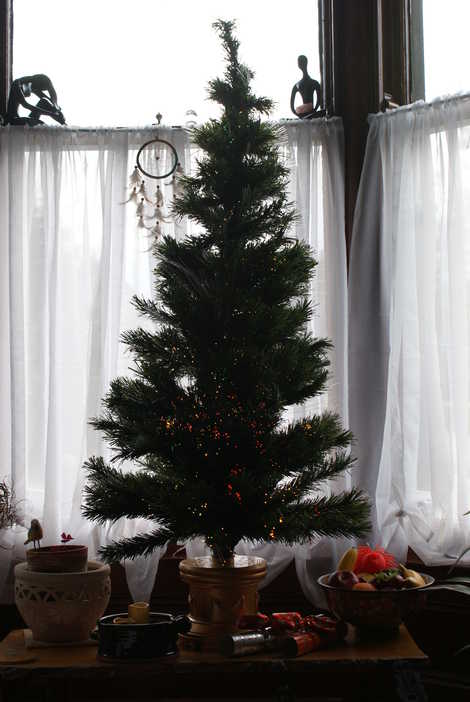
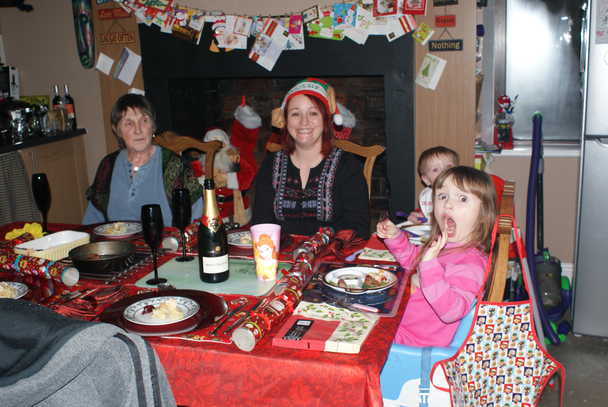
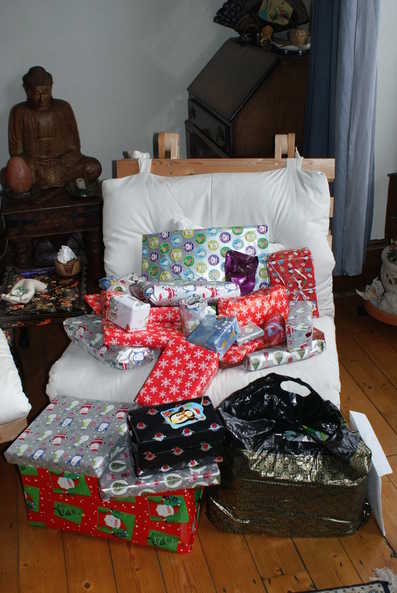
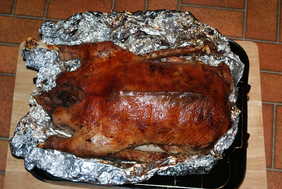
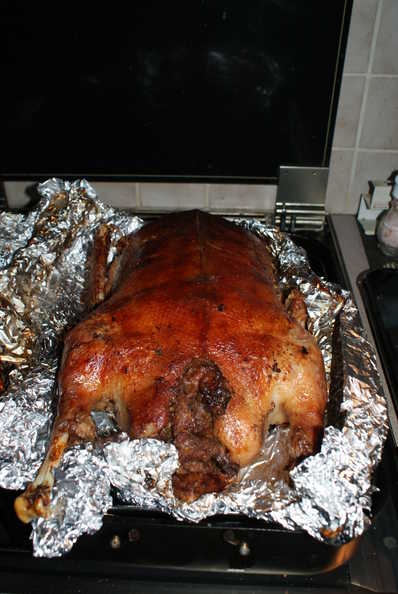
Pat the bird dry before carrying on with the roasting process.